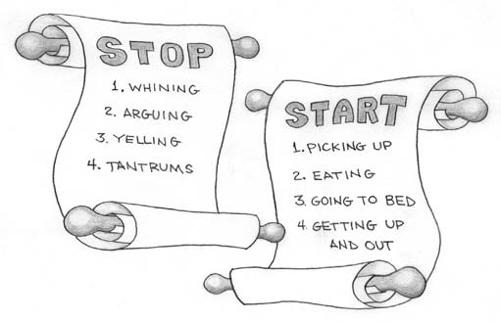The 1-2-3 Magic Workbook for Christian Parents: Effective Discipline for Children 2-12 (3 page)
Read The 1-2-3 Magic Workbook for Christian Parents: Effective Discipline for Children 2-12 Online
Authors: Thomas W. Phelan,Chris Webb
Tags: #Family & Relationships, #Parenting, #General

After reading in the hope of helping you to correct these er-
the
1-2-3 Magic
rors, the program presents fifty to seventy-five
book (or watching the
video), start the program
elaborate parenting strategies that require an
right away. Just thinking
advanced degree in psychology in order to be
about it will not change
able to use them properly. The result? You are
your kids’ behavior one
left with bad feelings, confusion and no clear
bit. But be ready—things
are going to change
place to start. Worse than that, things in your
quickly!
house or classroom stay the same.
After reading
1-2-3 Magic
, however, you
will know exactly what to do, what not to do, what to say and what not
to say in just about every one of the common, everyday problem situa-
tions you run into with your kids. Because
1-2-3 Magic
is based on only
a few basic but critical principles, you will be able not only to remember
what to do,
you will be able
to
do it
when you are anxious, agitated or
otherwise upset
(which for many of us parents is every day!). You will
also be able to be a kind but effective parent when you are busy, in a hurry
or otherwise preoccupied.
In addition to managing minor but frequent parenting problems, you
will also know how to handle more serious difficulties, such as lying,
stealing and fighting. With
1-2-3 Magic
there is—surprisingly—much less
in the way of technique and strategy to remember. That fact is extremely
important when an adult is trying to deal with an emotionally charged
situation involving a child. The strategies in this book are straightforward
and the parenting guesswork is minimal.
You will find that if you use the 1-2-3 correctly, it will work!
The
1-2-3 has been shown to be very effective with two-to-twelve-year-olds,
IS IT MAGIC? 9
whether they are “problem” children or just typical youngsters. In fact,
1-2-3 Magic
has been used successfully with learning disabled, attention
deficit and emotionally disturbed children, as well as with the visually
impaired and hearing impaired. It has been used with developmentally
and mentally impaired kids. To benefit properly from the 1-2-3, the only
rule is that
a child must have at least a mental age of about two
.
When you finish the
1-2-3 Magic
program—whether in book, video
or audio format—it is a good idea to start immediately. Talk with your
spouse or partner, if both of you are living at home, and then get going
right away. If you are a single parent, take a deep breath and then explain
the drill to your youngsters. Do the same thing if you’re a grandparent.
If you don’t start right away, you may never get around to it.
If you’re a teacher, begin explaining the 1-2-3 to your students, send
a letter home and have a parent night when you show the moms and dads
part of the
1-2-3 Magic
video. A picture is worth a thousand words, and
many of your parents, after seeing the video at school (especially the
Famous Twinkie Example), will want to start using the program at home.
The resulting school-home cooperation and consistency are often worth
their weight in gold, especially with more difficult children.
If you are a mental health professional or pediatrician, suggest that
your clients or patients get a copy of the
1-2-3 Magic
book at their local
bookstore. Or you can provide them with a copy of the book, video or
audio. If it’s the video, make sure you get a deposit or—sooner or later—
you’ll never see it again!
What to Expect When You Begin the 1-2-3
When you do start
1-2-3 Magic
, things will change quickly. But here there is good news and bad news. The good news is that initially about half of
all kids will fall into the “immediate cooperator” category. You start the
program and they cooperate right away—sometimes “just like magic.”
What do you do? Just relax and enjoy your good fortune!
The bad news is that the other half of the kids will fall into the
“immediate tester” category. These children will get worse first. They will
chal enge you to see if you real y mean business with your new parenting
ideas. If you stick to your guns, however—no arguing, yel ing or hitting—

10 1-2-3 MAGIC
you will get the vast majority of these little testers shaped up pretty well
in about a week to ten days. Then what do you do? You start enjoying
your children again.
Believe it or not, you may soon have a much more peaceful home
and more enjoyable kids. You will go back to liking and respecting your-
self as a parent—all in the foreseeable future! If you’re a teacher, you
will be less exhausted by discipline and you will have more time for
instruction.
Before we get into the details of the 1-2-3, we must clarify two very
important concepts:
1. The
two basic type
s
of problem behavior
(Chapter 2).
2. The
dangerous assumption
parents, teachers and other
caretakers make about young children (Chapter 3).
Points to Remember...
Once you start using
1-2-3 Magic
, there's good news and bad
news. Children will fall into one of two categories:
1. Immediate cooperators
2. Immediate testers
Enjoy the cooperators and brace youself for the testers!

2
Stop Behavior and Start Behavior
Stop teasing your sister and please start your homework!
There are two basic kinds of problems that children present to
adults. When you are frustrated with your youngsters, the kids are either
(1) doing something you want them to
Stop
, or (2) they are not doing some-
thing you would like them to
Start
. In
1-2-3 Magic
we therefore call these two kinds of things “Stop” behavior and “Start” behavior. In the hustle and
bustle of everyday existence, you may not have worried much about the
difference between Start and Stop behaviors, but—as we’ll soon see—the
distinction is extremely important. This distinction is also about to make
your life a lot easier!
Stop behavior includes the frequent, minor, everyday hassles kids pres-
ent to you, such as whining, disrespect, tantrums, arguing, teasing, fighting,
pouting, yelling and so on. Stop behavior—in and of itself—ranges from
mildly irritating to obnoxious. Each of these difficult behaviors alone may
not be so bad, but add them al up in one afternoon and by 5 p.m. you may
feel like hitchhiking to South America.
Start behavior includes positive activities like cleaning rooms, doing
homework, practicing the piano, getting up and out in the morning, go-
ing to bed, eating supper and being nice to other people. You have a Start
11

12 1-2-3 MAGIC
behavior problem when your child is not doing something that, in your
eyes, would be a good thing to do.
With Stop behavior problems, therefore, the issue is what the kids
are doing
. With Start behavior problems, the issue is what the kids
are not
doing
. The reason for distinguishing between these two kinds of behaviors
is this: You will use different tactics for each kind of problem.
For Stop behavior, such as whining, arguing, screaming and teasing,
you wil use the 1-2-3, or “counting” procedure. Counting is simple, gentle
and direct.
For Start behavior problems, you wil have
Quik Tip…
a choice of seven tactics, which can be used either
With Stop
singly or in combination. These tactics include
behavior, the issue
Praise, Simple Requests, Kitchen Timers, The
is what the kids
are
doing.
With Start behavior,
Docking System, Natural Consequences, Charting
the issue is what the kids
and a Variation of the 1-2-3. Start behavior strate-
are not doing.
There are
gies, as you can probably guess, require a lit le
different tactics for each
more thought and effort than counting does.
kind of problem. Don’t
worry, you’ll soon be
Why the difference in strategies? The
an expert in no time!
answer lies in the issue of motivation. How long
does it take a child—if she is motivated—to
terminate a Stop behavior like whining, arguing or teasing? The answer
is about one second; it’s really not a big project. And—depending on
how angry or oppositional a child is—terminating an obnoxious behavior
doesn’t take tons of effort.
But now look at Start behavior. How long does it take a child to eat
dinner? Maybe twenty to twenty-five minutes. To pick up after himself?
Perhaps fifteen minutes. To get ready for bed? Twenty to thirty minutes.
Ready for school? Thirty minutes. How about homework? Schoolwork
might take anywhere from forty minutes to three years. So it’s obvious that
with Start behavior, more motivation is required from the child. He has to
begin the project, keep at it and then finish it. And the project is often some-
thing the boy or girl is not thril ed about having to do in the first place.
In addition, if encouraging positive behavior in kids requires more
motivation in the kids, it’s also going to require more motivation from
mom and dad. As you’ll soon see, putting an end to Stop behavior using
counting is relatively easy if you do it right. Start behavior is harder.
